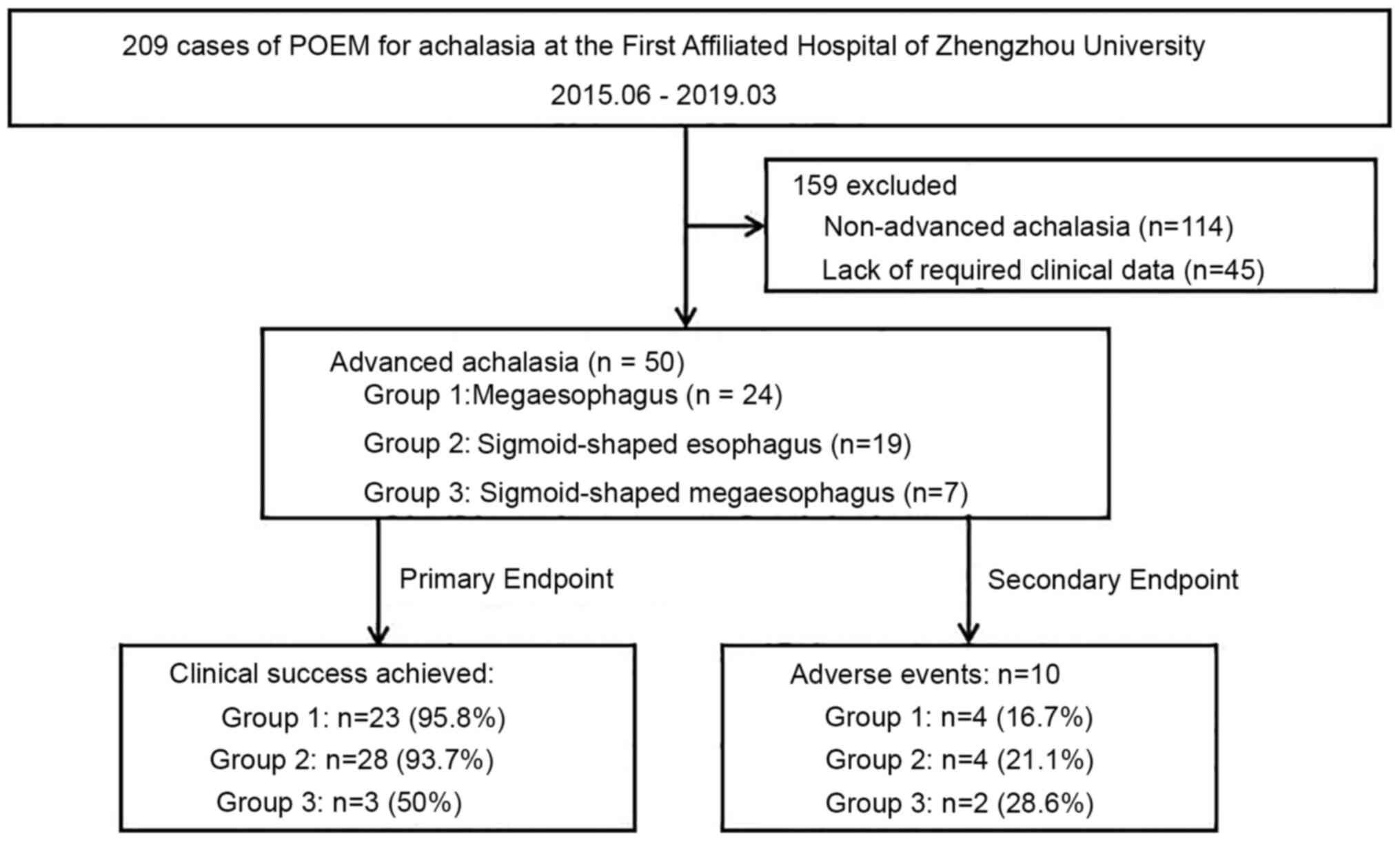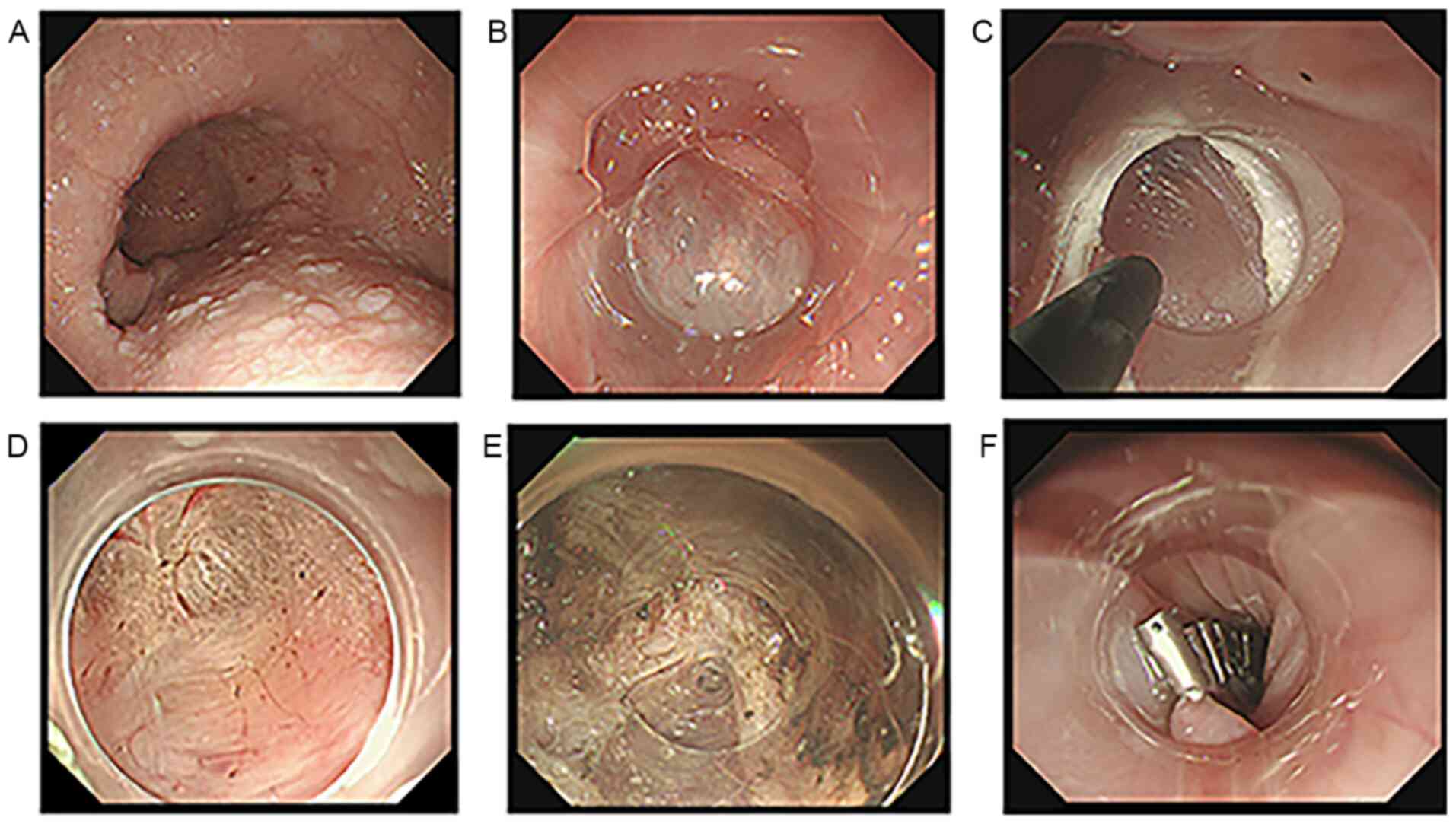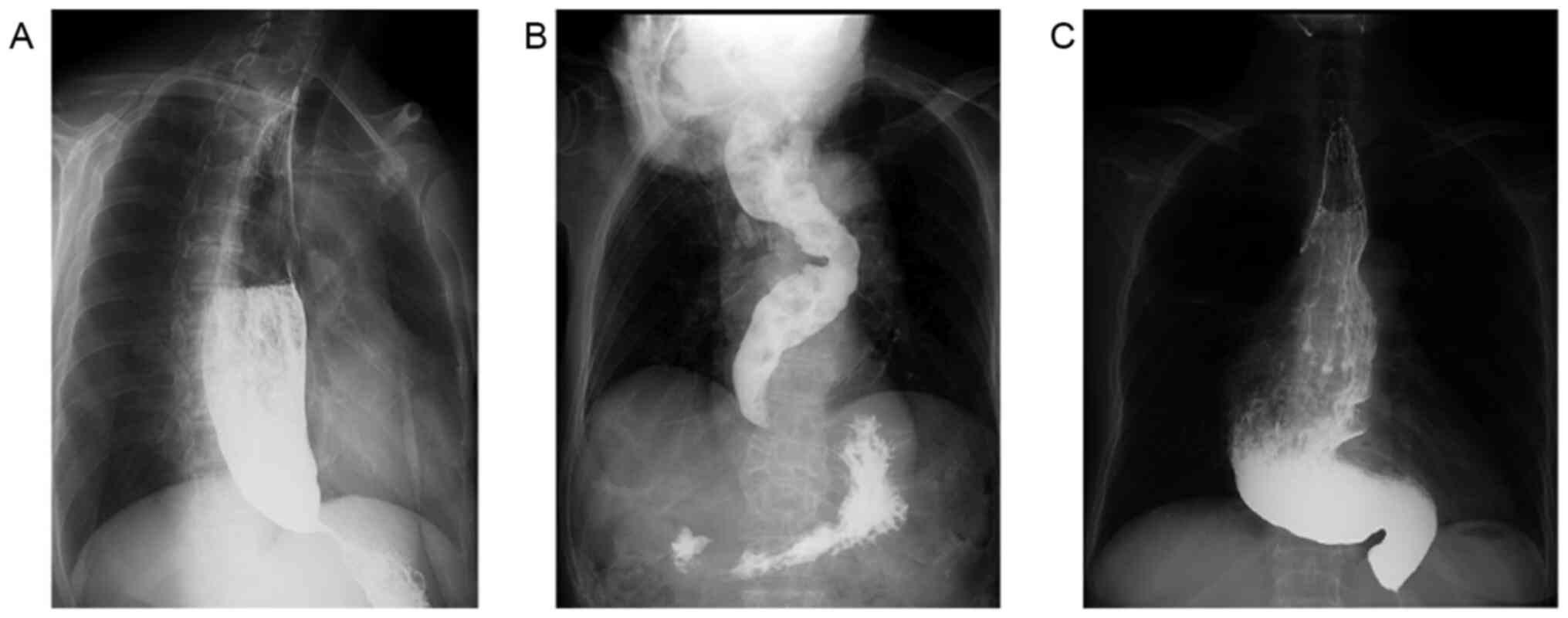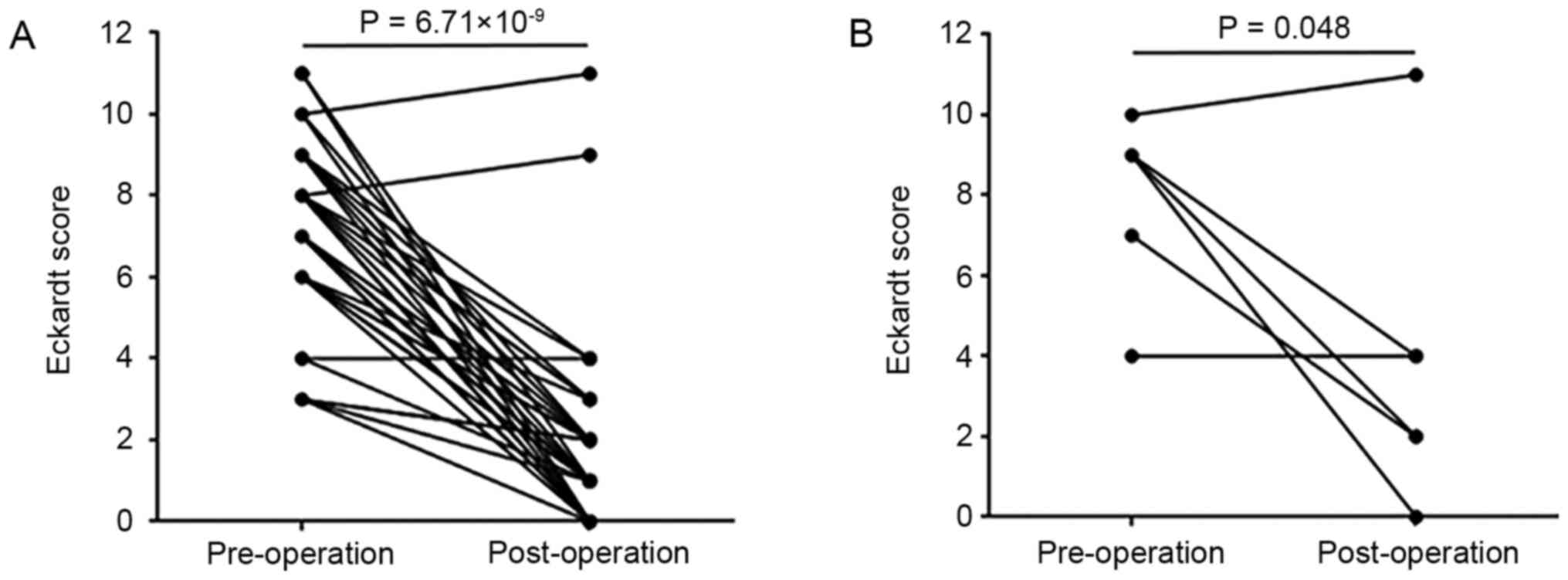Influence of esophageal morphology on the clinical efficacy of peroral endoscopic myotomy in treating advanced achalasia cardia
- Authors:
- Published online on: January 8, 2021 https://doi.org/10.3892/etm.2021.9629
- Article Number: 196
-
Copyright: © Liu et al. This is an open access article distributed under the terms of Creative Commons Attribution License.
Abstract
Introduction
Achalasia cardia (AC) is a primary esophageal motility disorder that presents with esophageal aperistalsis and impaired lower esophageal sphincter (LES) relaxation (1). Persistent severe AC may lead to excessive dilation and tortuosity of the esophagus a condition termed advanced AC (2,3). The esophageal morphology of advanced AC, including esophageal dilation, sigmoid-shaped esophagus and sigmoid-shaped megaesophagus, differs among individual patients. Cases of AC who exhibit subtle differences in their clinical presentation may exhibit distinctly different responses to current treatment modalities (4). To date, there is no definitive information correlating esophageal morphology and treatment outcome.
Peroral endoscopic myotomy (POEM), a technique based on submucosal tunneling and myotomy, was introduced into clinical practice by Inoue et al (5) in 2008. Now, it is the first line of treatment for AC. Despite limited experience, POEM has demonstrated superiority in treating advanced AC due to the capacity to perform long myotomy of the esophagus and the relative ease in locating the initial site for myotomy (6,7). To the best of our knowledge, however, studies addressing advanced AC treatment in cohorts stratified by their esophageal morphologies, which may impact the therapeutic results, are currently sparse. In addition, a dilated and tortuous esophageal lumen may make POEM more challenging and invasive. In the present study, the technical feasibility, safety and clinical efficacy of POEM in treating advanced AC were evaluated retrospectively. The influence of atypical esophageal morphology on treatment outcomes was determined.
Materials and methods
Patients and data collection
The present retrospective study was approved by the Institutional Review Board for Human Research of The First Affiliated Hospital of Zhengzhou University (Zhengzhou, China). All patients who underwent POEM for the treatment of achalasia (n=209) between June 2015 and March 2019 were included. The diagnosis of achalasia was based on the following: Clinical symptoms, radiological contrast swallow esophagography, esophagogastroduodenoscopy, esophageal manometry and/or chest computed tomography (CT) scan (8). Patients who exhibited coagulopathy or severe systemic disorders, which may lead to unsuitability for endoscopic therapy and pseudoachalasia, were excluded.
Advanced achalasia, defined as an esophagus lumen with a diameter of ≥6 cm and/or sigmoid in shape (9,10), was diagnosed in 50 patients according to images obtained from a barium swallow test and/or CT scan. All imaging was performed after fasting overnight and in the absence of esophageal clearance. A flow chart illustrating the clinical course of the present study is presented in Fig. 1. Adverse events (AEs) were defined according to the severity grading system of the American Society for Gastrointestinal Endoscopy (11).
Medical files collected prospectively were used to record baseline data, medical history, pre-POEM Eckardt score, intra-procedure parameters, procedure-related AEs and length of hospital stay. Medical records were also used to collect follow-up data. Clinical outcomes were evaluated by Eckardt symptom scoring (8). Delayed AEs were identified based upon self-declaration and endoscopic examination performed during follow-up consultation.
Study endpoints
The primary endpoint was the clinical response assessed by comparing pre- and post-procedural Eckardt scores collected at baseline and during the final follow-up visit, respectively. The secondary endpoints included intra-procedural details, such as operation time, length of myotomy, procedure-related AEs and hospital stay, as well as delayed AEs, i.e., gastroesophageal reflux disease (GERD).
Instruments and accessories
Instruments included a single-channel gastroscope (model type, GIF-H260 or GIF-Q260J), a Hook Knife (model type, KD-620LR) or triangle-tip knife (model type, KD-640L) and a CO2 insufflator (model type, UCR; all from Olympus Medical Systems Corp.). Furthermore, a high-frequency generator (model type, ICC 200 EA INT; ERBE), injection needle (model type, ET2522-C4; Endo-Flex), electrosurgical hemostatic forceps (model type, FD-410LR; Olympus Medical Systems Corp.) and clips (model type, ROCC-D-26-195; Micro-Tech Co., Ltd.; or no. HX-610-135; Olympus Medical Systems Corp.) were used.
Endoscopic myotomy techniques
Patients were fasted 24-48 h pre-operatively; food remnants were cleared from the esophagus prior to general anesthesia. Conventional POEM includes the following four steps described previously: i) Submucosal injection and mucosal incision; ii) submucosal tunneling; iii) myotomy to the LES and cardia; and iv) closure of the mucosal entry with endoscopic clips (Fig. 2) (12). Modified POEM incorporated tunneling and myotomy into a single step as described by Liu et al (13). All procedures were performed by 3 experienced endoscopists with at least 5 years of experience of performing conventional and modified POEM. A full-thickness myotomy at the LES and cardia, including the internal circular and longitudinal muscular layers, was performed on all patients.
Post-operative management and follow-up
Patients remained nil per os until the morning of the post-operative day. A clear liquid diet was then provided if no contraindications were identified. A CT scan and/or endoscopic re-check were scheduled to evaluate the possibility and severity of AE if any bleeding, chest pain, dyspnea, abdominal pain or distention, or emphysema occurred post-operatively. Further management of each patient was individualized. Asymptomatic patients were usually discharged on day 3. Upon discharge, all patients were prescribed a 4-week liquid diet and an oral proton pump inhibitor for 2 weeks.
Reflux esophagitis was evaluated and the current Eckardt score was determined at 1, 3, 6 and 12 months of follow-up. Esophagogastroduodenoscopy was recommended if serious symptoms occurred or refractory reflux was present.
Statistical analysis
All statistical analyses were performed using SPSS software, version 17.0 for Windows (SPSS, Inc.). Variables were expressed as the median (range). Count data were compared by Chi-square tests. Groups were compared using the Wilcoxon matched-pairs signed rank-sum test, Kruskal-Wallis test and Chi-square test. P<0.05 was considered to indicate statistical significance.
Results
Baseline characteristics
A total of 50 patients (22 females and 28 males) with a median age of 49 (21-86) years were enrolled between June 2015 and March 2019 (Table I). Each patient was categorized into one of three subgroups based upon esophageal morphology according to the Chicago Classification: Group 1, megaesophagus; group 2, sigmoid-shaped esophagus; and group 3, sigmoid-shaped megaesophagus (Fig. 3). The median history of symptoms was 91 (6-600) months; 40% of patients had a history of >10 years. The patients in group 3 usually presented a longer history than the patients in the other two groups (i.e., 240 months compared with 108 and 60 months for group 1 and 2, respectively; Table II), but the differences were not statistically significant. A total of 12 patients received treatment prior to POEM [endoscopic dilation (n=8), surgical myotomy (n=5) or both procedures (n=1)]. Treatment prior to POEM was performed in four patients in group 3 (57.1%); this was a significantly higher percentage of patients than in the other two subgroups (P=0.047; Table II). Over the course of a median of 25.3 (6-50) months, 46 patients completed the final follow-up visit. However, three patients in group 2 and one patient in group 3 did not complete the follow-up, one patient died because of acute obstructive suppurative cholangitis.
Table IIClinical characteristics and procedural parameters comparing three groups classified on the basis of esophageal morphology. |
POEM procedure and related AEs
Endoscopic myotomy was performed successfully on all 50 patients (conventional POEM on 20 patients and modified POEM on 30 patients). The median operating time of POEM was 43 (16-163) min, and the time of modified POEM was 29 (11-65) min. The length of myotomy was determined endoscopically by each operator taking the proximal condition of the esophageal lumen into account. The median length of the esophageal myotomy was 8 (5-14) cm, albeit longer than 10 cm in 10 patients (21.7%; Table I). The median length of post-operative hospital stay was 5.5 (3-11) days.
Procedure-related AEs were reported in 10 patients and were as follows: Air-related emphysema, intra-operative and post-operative bleeding, mucosal injury, perforation and post-operative chest pain (Table I). Occasionally, two or more AEs occurred simultaneously in the same patient. All AEs were mild (n=8) or moderate (n=6) and did not require surgical conversion or admission to the intensive care unit. None of the patients with cutaneous emphysema had dyspnea and they were diagnosed by self-reporting and physical examination, without drainage or decompression. The mucosal failures, which occurred in the 3 patients who suffered mucosal injury or perforation, were detected prior to withdrawing the endoscope and managed similarly: Clipping, esophageal or gastric decompression and post-operative antibiotics. A total of three cases of bleeding occurred among the patients in group 2 (Table II). Hemostasis was achieved intraoperatively using endoscopic vessel coagulation. Sengstaken-Blakemore tube compression was applied after hemostasis in one patient in order to avoid re-bleeding of the vascular stump. The Sengstaken-Blakemore tube was removed on day 3 and the patient was discharged on day 9 without any signs of bleeding. In a second patient, post-operative bleeding manifested as melena and a drop in hemoglobin on the third day after POEM. Upon endoscopic re-examination, a submucosal hematoma was detected as a sign of recent bleeding along the submucosal tunnel. A Sengstaken-Blakemore tube was placed and compressed for 3 days. This patient reported no further symptoms of bleeding and was discharged without any further intervention.
Clinical outcomes of endoscopic myotomy on advanced AC
Clinical success, defined as a final Eckardt score ≤3 achieved during the 6- to 50-month follow-up period, occurred in 41 patients in whom the mean Eckardt score decreased from 7 (3-11) to 1 (0-11) (Fig. 4A). A post-procedure Eckardt score of 0 was achieved and sustained (a complete response) in 13 patients during a 14.6 (7.2-33.8) month follow-up period. A total of 5 patients, who did not respond successfully, relapsed in a median time of 19.8 (15.6-38.0) months. One of these patients never experienced any symptomatic relief and underwent thoracic surgical myotomy 6 months after modified POEM; the remaining 4 patients did not pursue any further intervention after relapsing. Of note, although 50% of the patients in group 3 achieved clinical success (Fig. 4B), this rate was significantly lower than that achieved for the other two groups (95.8% for group 1 and 93.7% for group 2; P=0.004; Table II).
Post-operative reflux
Symptomatic reflux occurred in 13 of 46 patients who completed their follow-up visit. Among these patients, 2 experienced episodes of reflux every day and reflux occurred in the other patients occasionally. A total of 5 patients took a proton pump inhibitor to relieve the symptoms of reflux; all symptoms were readily controlled by intermittent oral medication. Upper endoscopy was performed on 8 patients chosen at random to evaluate the severity of reflux esophagitis. Furthermore, seven patients had mild esophagitis (Los Angeles classification A) and 1 patient suffered severe esophagitis (Los Angeles classification C) (14). There was no significant difference in the occurrence and severity of GERD among the morphological subgroups (P=0.202; Table II).
Discussion
A limited number of studies have reported on the clinical outcomes of POEM for advanced AC; most of these studies focused on the sigmoid-shaped esophageal morphology (9,15-17). In a clinical setting, however, morphologic changes in the esophagus vary dependent upon multiple factors, such as symptomatic history, esophageal body contraction and LES pressure. A proportion of patients who exhibit a significantly dilated esophagus for a relatively long period with no signs of angulation (also termed advanced AC) experience dysfunction and poor clinical outcomes (18). Consequently, a retrospective analysis was performed in the present study to determine the safety and efficacy of POEM on advanced AC categorized based upon esophageal morphology, i.e., megaesophagus, sigmoid-shaped esophagus and sigmoid-shaped megaesophagus.
Although laparoscopic Heller myotomy is recommended as the initial treatment for patients with advanced achalasia, myotomy does not provide relief of dysphagia for most of these individuals. Rather, patients with end-stage achalasia esophagus may ultimately require esophagectomy, where symptom resolution reportedly occurs in 75-100% of patients (10,19-21). Due to high risk associated with the surgery and its unclear impact on the long-term quality of life, however, surgeons are reluctant to perform esophagectomy for benign conditions such as achalasia. Initial results indicated that POEM was less invasive and an effective technique for treating advanced AC. Endoscopists reported clinical success rates of 95.6 and 100% for sigmoid-type advanced AC after a minimum follow-up period of 12 months (15,16). Although the overall success rate was 89.1% in the present study, patients with a sigmoid-shaped megaesophagus (group 3) did not respond as well as patients in the other two subgroups. Indeed, the clinical success rate for patients with prior treatment in group 3 was only 33.3%. Given the low incidence of advanced AC, only 7 patients with sigmoid-shaped megaesophagus were enrolled in the present study. Therefore, these results require further confirmation.
POEM may be technically challenging and time-consuming in cases of advanced AC that involve morphological changes and submucosal fibrosis caused by prior treatment (22). Mucosal damage, small perforations and gas-related AEs were the most frequent procedure-related AEs, which occurred in 37.5 and 34.8% of patients, respectively, in previous studies (15,16). In the present study, the overall incidence of AEs in the cohort was 20%. Bleeding and mucosal damage were the most severe AEs encountered and usually required intervention. The frequency of AEs was much lower than that previously reported, possibly due to the fact that CT scans were only recommended for patients who exhibited alarm symptoms post-operatively, while previous studies routinely used CT scans after POEM (23). Since the results of a majority of CT scans are minor and clinically irrelevant, routine scans are probably not warranted.
In the present study, patients with a sigmoid-shaped esophagus were more prone to AE compared to the other two morphological subgroups. Major intra-procedural bleeding and post-procedural bleeding were noticed intra-operatively. Bleeding spots came from large vessels penetrating the muscularis, which may be complicated by angulation along the cutting direction during myotomy. Our experience suggests that it is helpful to compress the active bleeding site with a cap attached to the tip of the endoscope in an effort to maintain clear vision and identify the bleeding vessels. The addition of a water jet allows for accurate localization when active bleeding occurs. Hemostasis with coagulation forceps was absolutely essential when major active bleeding occurred. Finally, Sengstaken-Blakemore tube compression worked for both intra- and post-operative bleeding under certain circumstances, as described previously (24). It should be emphasized that in the present study, a Sengstaken-Blakemore tube was only used during the early period of the POEM application, i.e., when precise submucosal dissection and hemostasis techniques were fairly new (24). Otherwise, Sengstaken-Blakemore tubes should only be used in carefully selected cases based upon the bleeding site and whether hemostasis was readily achieved (24).
Despite the promising results, the present study had several limitations. Firstly, it was a retrospective study. Furthermore, the POEM and modified POEM procedures were performed by different experienced endoscopists, and the operative skills may be different among endoscopists. In addition, only 34% of cases underwent high-resolution manometry before operation, due to difficult placement in cases of severely dilated and tortuous esophagi amongst patients with advanced AC.
In conclusion, the present study provided broad support for the efficacy of the POEM procedure in treating patients with advanced AC. POEM is also a technically feasible and safe option in treating patients with a sigmoid-shaped megaesophagus, although the rate of clinical success was less than that achieved for the other treatment groups. Additional prospective, multicenter randomized controlled studies are required.
Acknowledgements
The authors would like to thank Dr Stephen H. Gregory (Department of Gastroenterology, Rhode Island Hospital, Brown University, Providence, RI, USA) for his help with the writing and editing of this manuscript.
Funding
The present study was supported by the Science and Technology Foundation of Henan Province (grant no. 2018020115) and the Overseas Research and Training Project of Henan Province (grant no. 2018143).
Availability of data and materials
All data generated and analyzed in the present study are included in this article.
Authors' contributions
DL: Conception, design and critical revision of the manuscript. YYL and JXC: Data acquisition, preparation of the figures and writing the first draft of the manuscript. LS, SU, YYZ, LXZ and BH: Acquisition of the clinical data and images. QFZ, LXZ and BH: Patient follow-up. DYL and DZH: POEM. BRL: POEM and critical revision of the manuscript. DL and YYL confirm the authenticity of all the raw data. All authors read and approved the final manuscript.
Ethics approval and consent to participate
This study was approved by the Institutional Review Board for Human Research of The First Affiliated Hospital of Zhengzhou University (Zhengzhou, China).
Patient consent for publication
Not applicable.
Competing interests
The authors declare that they have no competing interests.
References
|
Boeckxstaens GE, Zaninotto G and Richter JE: Achalasia. Lancet. 383:83–93. 2014.PubMed/NCBI View Article : Google Scholar | |
|
Patti MG, Gorodner MV, Galvani C, Tedesco P, Fisichella PM, Ostroff JW, Bagatelos KC and Way LW: Spectrum of esophageal motility disorders: Implications for diagnosis and treatment. Arch Surg. 140:442–448; discussion 448-449. 2005.PubMed/NCBI View Article : Google Scholar | |
|
Shiino Y, Houghton SG, Filipi CJ, Awad ZT, Tomonaga T and Marsh RE: Manometric and radiographic verification of esophageal body decompensation for patients with achalasia. J Am Coll Surg. 189:158–163. 1999.PubMed/NCBI View Article : Google Scholar | |
|
Andolfi C and Fisichella PM: Meta-analysis of clinical outcome after treatment for achalasia based on manometric subtypes. Br J Surg. 106:332–341. 2019.PubMed/NCBI View Article : Google Scholar | |
|
Inoue H, Minami H, Kobayashi Y, Sato Y, Kaga M, Suzuki M, Satodate H, Odaka N, Itoh H and Kudo S: Peroral endoscopic myotomy (POEM) for esophageal achalasia. Endoscopy. 42:265–271. 2010.PubMed/NCBI View Article : Google Scholar | |
|
von Rahden BH, Filser J, Reimer S, Inoue H and Germer CT: Peroral endoscopic myotomy for treatment of achalasia. Literature review and own initial experience. Chirurg. 85:420–432. 2014.PubMed/NCBI View Article : Google Scholar : (In German). | |
|
Awaiz A, Yunus RM, Khan S, Memon B and Memon MA: Systematic review and meta-analysis of perioperative outcomes of peroral endoscopic myotomy (POEM) and laparoscopic Heller myotomy (LHM) for achalasia. Surg Laparosc Endosc Percutan Tech. 27:123–131. 2017.PubMed/NCBI View Article : Google Scholar | |
|
Schlottmann F and Patti MG: Esophageal achalasia: Current diagnosis and treatment. Expert Rev Gastroenterol Hepatol. 12:711–721. 2018.PubMed/NCBI View Article : Google Scholar | |
|
Bazerbachi F, Blackmon SH, Ravi K and Wong Kee Song LM: Endoscopic esophagoplasty for megaesophagus with sump stasis in end-stage achalasia. VideoGIE. 2:274–275. 2017.PubMed/NCBI View Article : Google Scholar | |
|
Aiolfi A, Asti E, Bonitta G, Siboni S and Bonavina L: Esophageal Resection for End-Stage Achalasia. Am Surg. 84:506–511. 2018.PubMed/NCBI | |
|
Cotton PB, Eisen GM, Aabakken L, Baron TH, Hutter MM, Jacobson BC, Mergener K, Nemcek A Jr, Petersen BT, Petrini JL, et al: A lexicon for endoscopic adverse events: Report of an ASGE workshop. Gastrointest Endosc. 71:446–454. 2010.PubMed/NCBI View Article : Google Scholar | |
|
Liu ZQ, Li QL, Chen WF, Zhang XC, Wu QN, Cai MY, Qin WZ, Hu JW, Zhang YQ, Xu MD, et al: The effect of prior treatment on clinical outcomes in patients with achalasia undergoing peroral endoscopic myotomy. Endoscopy. 51:307–316. 2019.PubMed/NCBI View Article : Google Scholar | |
|
Liu BR, Song JT and Omar Jan M: Video of the month. Modified peroral endoscopic myotomy. Am J Gastroenterol. 110(499)2015.PubMed/NCBI View Article : Google Scholar | |
|
Armstrong D, Bennett JR, Blum AL, Dent J, De Dombal FT, Galmiche JP, Lundell L, Margulies M, Richter JE, Spechler SJ, et al: The endoscopic assessment of esophagitis: A progress report on observer agreement. Gastroenterology. 111:85–92. 1996.PubMed/NCBI View Article : Google Scholar | |
|
Hu JW, Li QL, Zhou PH, Yao LQ, Xu MD, Zhang YQ, Zhong YS, Chen WF, Ma LL, Qin WZ, et al: Peroral endoscopic myotomy for advanced achalasia with sigmoid-shaped esophagus: Long-term outcomes from a prospective, single-center study. Surg Endosc. 29:2841–2850. 2015.PubMed/NCBI View Article : Google Scholar | |
|
Lv L, Liu J, Tan Y and Liu D: Peroral endoscopic full-thickness myotomy for the treatment of sigmoid-type achalasia: Outcomes with a minimum follow-up of 12 months. Eur J Gastroenterol Hepatol. 28:30–36. 2016.PubMed/NCBI View Article : Google Scholar | |
|
Kumbhari V, Tieu AH, Onimaru M, El Zein MH, Teitelbaum EN, Ujiki MB, Gitelis ME, Modayil RJ, Hungness ES, Stavropoulos SN, et al: Peroral endoscopic myotomy (POEM) vs laparoscopic Heller myotomy (LHM) for the treatment of Type III achalasia in 75 patients: A multicenter comparative study. Endosc Int Open. 3:E195–E201. 2015.PubMed/NCBI View Article : Google Scholar | |
|
Rhee K, Jeon H, Kim JH, Yoon YH, Park H and Lee SI: An evidence of esophageal decompensation in patients with achalasia in the view of its subtype: A retrospective study. J Neurogastroenterol Motil. 19:319–323. 2013.PubMed/NCBI View Article : Google Scholar | |
|
Salvador R, Costantini M, Zaninotto G, Morbin T, Rizzetto C, Zanatta L, Ceolin M, Finotti E, Nicoletti L, Da Dalt G, et al: The preoperative manometric pattern predicts the outcome of surgical treatment for esophageal achalasia. J Gastrointest Surg. 14:1635–1645. 2010.PubMed/NCBI View Article : Google Scholar | |
|
Aiolfi A, Asti E, Bonitta G and Bonavina L: Esophagectomy for end-stage achalasia: Systematic review and meta-analysis. World J Surg. 42:1469–1476. 2018.PubMed/NCBI View Article : Google Scholar | |
|
Devaney EJ, Lannettoni MD, Orringer MB and Marshall B: Esophagectomy for achalasia: Patient selection and clinical experience. Ann Thorac Surg. 72:854–858. 2001.PubMed/NCBI View Article : Google Scholar | |
|
Wu QN, Xu XY, Zhang XC, Xu MD, Zhang YQ, Chen WF, Cai MY, Qin WZ, Hu JW, Yao LQ, et al: Submucosal fibrosis in achalasia patients is a rare cause of aborted peroral endoscopic myotomy procedures. Endoscopy. 49:736–744. 2017.PubMed/NCBI View Article : Google Scholar | |
|
Cai M-Y, Zhou P-H, Yao L-Q, Zhu B-Q, Liang L and Li Q-L: Thoracic CT after peroral endoscopic myotomy for the treatment of achalasia. Gastrointest Endosc. 80:1046–1055. 2014.PubMed/NCBI View Article : Google Scholar | |
|
Li QL, Zhou PH, Yao LQ, Xu MD, Chen WF, Hu JW, Cai MY, Zhang YQ, Zhong YS, Qin WZ, et al: Early diagnosis and management of delayed bleeding in the submucosal tunnel after peroral endoscopic myotomy for achalasia (with video). Gastrointest Endosc. 78:370–374. 2013.PubMed/NCBI View Article : Google Scholar |













